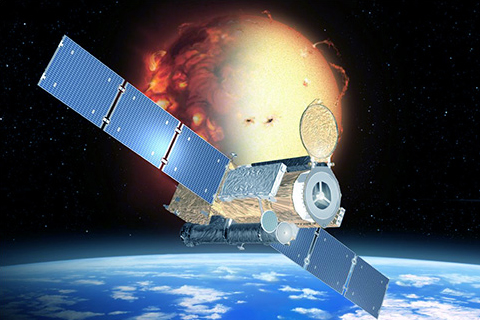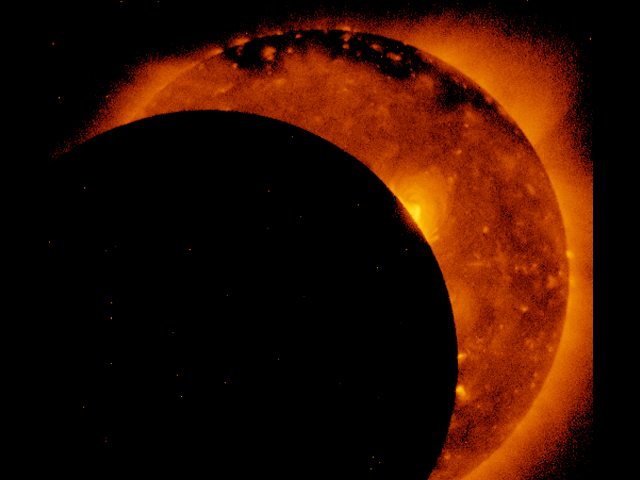About Solar Physics Satellite "HINODE" (SOLAR-B)

|
The HINODE, an observatory satellite to study the impact of the Sun on the Earth High expectations for new solar observations through international efforts by the United Kingdom, the United States and JapanThe HINODE (SOLAR-B), which is the successor to the orbiting solar observatory YOHKOH (SOLAR-A), was launched at 6:36 a.m. on September 23, 2006 (JST) by the M-V Launch Vehicle No.7 from the Uchinoura Space Center. The satellite had been coordinated and developed by the United Kingdom, the United States and Japan. Each party had the following responsibilities. The satellite systems were developed by JAXA and Mitsubishi Electric Corporation. The large solar optical telescope (SOT) was jointly developed by the United States and Japan. JAXA and the National Astronomical Observatory of Japan worked on the telescope optics and the U.S. National Aeronautics and Space Administration (NASA) developed the focal-plane package (FPP). For the X-ray telescope (XRT), NASA provided grazing-incidence mirror optics, while JAXA provided the CCD camera. Development of the Extreme Ultraviolet (EUV) Imaging Spectrometer is being led by the Particle Physics and Astronomy Research Council (PPARC) of the United Kingdom with the support of NASA and JAXA. Launch date: September 23, 2006 |
|---|
Project Topics
indexGreat American Eclipse on 21 August 2017: public release of images and videos taken by the "Hinode" satellite

|
The Japan Aerospace Exploration Agency (JAXA), the National Astronomical Observatory of Japan (NAOJ/NINS), and the US National Aeronautics and Space Administration (NASA), release partial eclipse images and videos taken on August 22 (JST) with the solar observation satellite "Hinode". The images and videos were taken on August 22, 2017 at 1:57 JST with the X-Ray Telescope (XRT) aboard "Hinode" during its flight above the Pacific Ocean (off the west coast of the US) at an altitude of 680km. Th... |
|---|
Press Release
index-
- Oct. 10, 2017 (09:30) [release]
- "Invisible" Solar Nanoflares confirmed by ultra-high sensitivity observations
Characteristics of Solar Physics Satellite "HINODE" (SOLAR-B)
The satellite mission’s main scientific aim is to unravel some of the mysteries and mechanisms of the activities taking place in the solar corona.
|
The Sun is the only fixed star available for us to observe in detail. By focusing on it, scientists hope to get a better understanding of the mechanisms of various processes taking place in the Universe. HINODE will carry a coordinated set of optical, X-ray, and EUV instruments that will perform highly accurate measurements of magnetic fields, electrical currents and velocity fields in the solar atmosphere and corona. The result will be an improved understanding of the mechanisms of solar explosions, which will in turn greatly help us predict how solar events affect Earth. The satellite’s polar orbit will allow its instruments to stay in continuous contact with the Sun for nine months of the year. HINODE will operate for at least three years. |

|
|---|
Major Characteristics
| International Designation Code | 2006-041A |
|---|---|
| Launch Date | 06:36, September 23, 2006 (JST) |
| Launch Vehicle | M-V-7 |
| Location | Uchinoura Space Center |
| Shape | Approx. 1.6m x 1.6m x 4m 10m long from end to end of solar array paddles |
| Weight | Approx. 900 kg |
| Orbiter | Circular (Sun-synchronous polar) |
| Altitude | Approx. 680 km |
| Inclination | 98 degrees |
| Period | 98 min |
Mission talk by team leaders

|
Project Manager Taro SakaoHere are messages from Project Managers. |
|---|
Contents

- May. 27, 2008
- Approaching the Infinite Mysteries of Space

- Oct. 19, 2006
- Solar Observation Satellite Hinode (SOLAR-B)